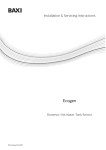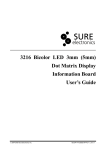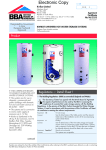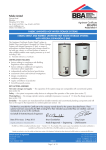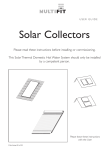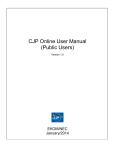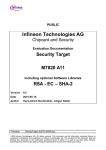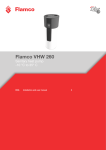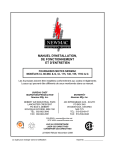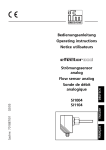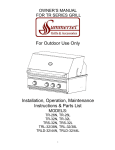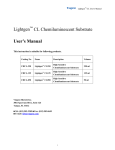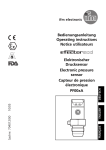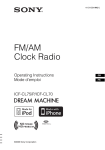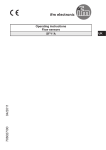Download Electronic Copy - RIBA Product Selector
Transcript
Electronic Copy CI/SfB (53.3) Heatrae Sadia Heating Limited Hurricane Way Norwich Norfolk NR6 6EA Tel: 01603 424144 Fax: 01603 409409 Designated by Government to issue European Technical Approvals Product • THIS CERTIFICATE REPLACES CERTIFICATE NO 92/2743 AND RELATES TO MEGAFLO UNVENTED HOT WATER STORAGE SYSTEMS. • The systems are for use in domestic, commercial and public buildings with domestic hot and cold water services to BS 6700 : 1987. • The systems are for connection to mains water supply at pressures up to 12 bar. • It is essential, for reasons of safety and performance, that the systems are installed and maintained in accordance with this Certificate. X Agrément Certificate No 95/3094 MEGAFLO UNVENTED HOT WATER STORAGE SYSTEMS Système d’eau chaude sanitaire Heißwasserbereiter Regulations, Legislation and Byelaws 1 The Building Regulations (England and Wales) The Secretary of State has agreed with the British Board of Agrément the aspects of performance to be used by the BBA in assessing the compliance of unvented hot water storage systems with the Building Regulations. In the opinion of the BBA, the position of Megaflo Unvented Hot Water Storage Systems under the Regulations, if used in accordance with the provisions of this Certificate, is as stated in Detail Sheet 1. 2 The Building Standards (Scotland) Regulations In the opinion of the BBA, the position of Megaflo Unvented Hot Water Storage Systems under the Regulations, if used in accordance with the provisions of this Certificate, is as stated in Detail Sheet 1. 3 The Building Regulations (Northern Ireland) In the opinion of the BBA, the position of Megaflo Unvented Hot Water Storage Systems under the Building Regulations, if used in accordance with the provisions of this Certificate, is as stated in Detail Sheet 1. 4 The Health and Safety at Work etc Act 1974 and the Health and Safety at Work (Northern Ireland) Order 1978 In the opinion of the BBA, the position of Megaflo Unvented Hot Water Storage Systems under the Act and Order, if used in accordance with the provisions of this Certificate, is as stated in Detail Sheet 1. 5 Water Byelaws and Regulations In the opinion of the BBA, the position of Megaflo Unvented Hot Water Storage Systems under the Byelaws and Regulations, if used in accordance with the provisions of this Certificate, is as stated in Detail Sheet 1. Readers are advised to check that this Certificate has not been withdrawn or superseded by a later issue, by either referring to the Index of Current BBA Publications or contacting the BBA direct (Telephone Hotline 01923 662900). Electronic Copy 6.3 In granting this Certificate, the BBA makes no Conditions of Certification representation as to the presence or absence of patent rights subsisting in these products and/or as to the legal right of Heatrae Sadia Heating Limited to market, install or maintain these products. 6 Conditions 6.1 The quality of materials and the method of manufacture have been examined and found satisfactory by the BBA and must be maintained to this standard during the period of validity of this Certificate. This Certificate will remain valid for an unlimited period provided that: (a) the specification of the products is unchanged, and (b) the manufacturer continues to have the products checked by the BBA. 6.2 Where reference is made in this Certificate to any Act of Parliament, Regulation made thereunder, Statutory Instrument, Code of Practice, British Standard, manufacturer’s instruction or similar publication, it shall be construed as reference to such publication in the form in which it is in force at the date of this Certificate. 6.4 It should be noted that any recommendations relating to the safe use of these products which are contained or referred to in this Certificate are the minimum standards required to be met when the products are used. They do not purport in any way to re-state the requirements of the Health and Safety at Work etc Act 1974, or of any other statutory or Common Law duties of care, or of any duty of care which may in the future exist; nor is conformity with such recommendations to be taken as satisfying the requirements of the 1974 Act or of any other present or future statutory or Common Law duties of care. In granting this Certificate, the BBA does not accept responsibility to any person or body for any loss or damage incurred in respect of personal injury arising as a direct or indirect result of the use of these products. In the opinion of the British Board of Agrément, Megaflo Unvented Hot Water Storage Systems are fit for their intended use if used as set out in this Certificate. Certificate No 95/3094 is accordingly awarded to Heatrae Sadia Heating Limited. On behalf of the British Board of Agrément Date of issue: 22nd February 1995 British Board of Agrément P O Box No 195, Bucknalls Lane Garston, Watford, Herts WD2 7NG Fax: 01923 662133 Director For technical or additional information, tel: 01923 670844. For information about Agrément Certificate validity and scope, tel: ©1995 Hotline: 01923 662900 Electronic Copy CI/SfB (53.9) Heatrae Sadia Heating Limited X Certificate No 95/3094 MEGAFLO UNVENTED HOT WATER STORAGE SYSTEMS DETAIL SHEET 2 Second issue* Components • THIS DETAIL SHEET LISTS THE COMPONENTS APPROVED FOR USE ON MEGAFLO UNVENTED HOT WATER STORAGE SYSTEMS. • Each product Detail Sheet lists the components that are required to be factory fitted and others which are supplied separately for fitting by the installer.• The BBA has assessed each of the components as suitable for purpose. This Detail Sheet must be read in conjunction with the Front Sheet and the relevant Detail Sheets. Component Manufacturer/supplier and component number Setting Size Line strainer Reliance Water Controls LS75 — ¾” Pressure control valve Honeywell D07 Desbordes 9BisFX Reliance Water Controls 312 3 bar 3 bar 3 bar ¾” ¾” ¾” Check valve Reliance Water Controls SC75 — 22 mm Combined control valve set Reliance Water Valves 2014 expansion valve set at 8 bar Combined temperature and pressure relief valve Flamco Reliance 90°C/10 bar 90°C/10 bar ¾” ¾” Tundish Reliance Water Controls — 22 mm to 1” Immersion heater Megaflo 90105151 Direct non-self-resetting thermal cut-out Cotherm Type TUS 0228 77° to 83°C Direct thermostat Cotherm Type TUS 0228 10° to 70°C Indirect non-self-resetting thermal cut-out Cotherm Type GTLHR 038 75° to 85°C Indirect thermostat Cotherm Type GTLH 3101 10° to 70°C Motorized valve* Honeywell V4043 Danfoss DMV2C Sunvic SZV 2212 F 1¾” BSP *It is essential on indirectly heated systems that the motorized valve supplied with the system is installed and is not substituted by any other motorized valve which may exist and be in service at the site of installation, eg a motorized valve installed in a central heating circuit. Note: The replacement or servicing of any components must be carried out, using the Megaflo Installation Manual, by a competent person (see section 15 of each system Detail Sheet), or by Heatrae Sadia Heating Limited under their responsibility as the product manufacturer, including that required by their warranty, using components supplied by Heatrae Sadia Heating Limited. Readers are advised to check the validity of this Detail Sheet by either referring to the Index of Current BBA Publications or contacting the BBA direct (Telephone Hotline 01923 662900). Electronic Copy On behalf of the British Board of Agrément Date of Second issue: 4th February 1997 Director *Original Detail Sheet issued 22nd February 1995. This amended version includes changes to components list (indirect thermal cut-out and thermostat). British Board of Agrément P O Box No 195, Bucknalls Lane Garston, Watford, Herts WD2 7NG Fax: 01923 662133 For technical or additional information, tel: 01923 670844. For information about Agrément Certificate validity and scope, tel: ©1997 Hotline: 01923 662900 Electronic Copy CI/SfB (53.3) Heatrae Sadia Heating Limited MEGAFLO DIRECT UNVENTED HOT WATER STORAGE SYSTEM X Certificate No 95/3094 DETAIL SHEET 3 Product • THIS DETAIL SHEET RELATES TO THE MEGAFLO DIRECT UNVENTED HOT WATER STORAGE SYSTEM WITH A RANGE OF CAPACITIES FROM 70 TO 300 LITRES, A NOMINAL OPERATING PRESSURE OF 3 BAR AND SUPPLIED WITH ONE, TWO OR THREE 3 kW IMMERSION HEATERS. • The system is for use with mains or other suitable potable water supply pressures up to and including 12 bar. • Satisfactory outlet flow rates can only be achieved where the flow rate available at the entry to the system is adequate (see section 5). • It is essential, for reasons of safety and performance, that the product is installed and maintained in accordance with the requirements of this Detail Sheet by a competent person (see section 12, regarding Maintenance and section 15 for the definition of a competent person). This Detail Sheet must be read in conjunction with the Front Sheet and Detail Sheet 1, which give Conditions of Certification and the product’s position regarding the Building Regulations, respectively. Technical Specification 1 Description 1.1 The Megaflo Direct Unvented Hot Water Storage System is for use in domestic, commercial and public buildings for connection to domestic hot and cold water services to BS 6700 : 1987, and comprises the components shown in Figure 1. The storage capacities and main dimensions are listed in Table 1. 1.2 The system generally comprises a stainless steel storage cylinder supplied with one, two or three immersion heaters. The system is for free standing installation and connects to a cold feed supply as indicated in Table 1. 1.3 The cylinder is insulated with polyurethane (PU) hard foam and covered in a white polyvinyl chloride (PVC) coated galvanized steel outer casing. 1.4 For safety of the system, electrical control devices and the combined temperature and pressure relief valve are factory fitted. Other components including additional safety devices are supplied separately for fitting on site (see Figure 1 and section 2.1) by a competent person (see section 15). 1.5 Factory production control is exercised during the manufacture and assembly of each of the components including visual examination, dimensional checks and performance tests. Each storage cylinder is pressure tested and examined for leaks during manufacture and prior to dispatch. 1.6 When the system is commissioned an air gap is trapped at the top of the storage cylinder to accommodate expansion of the heated water (see Figure 2). 2 Delivery and site handling 2.1 The complete system is delivered to site boxed. The following components (see also Detail Sheet 2 of this Certificate) are supplied separately with each storage cylinder for fitting on site by a competent person, all other components are factory fitted: cold water control valves to include: pressure reducing valve strainer, check valve and expansion relief valve tundish immersion heater(s). 2.2 When the system is required to be stored, it must be stored in a dry environment and protected from damage. 2.3 The system must be carefully handled and kept in the delivery carton until required for siting in position. The weight of each system empty and full is stated in Table 1 and on the label attached to each cylinder. 3 Labelling/marking The system carries a label (or labels) bearing the information set out in Table 2 and is supplied with a comprehensive installation/user manual. Readers are advised to check that this Detail Sheet has not been withdrawn or superseded by a later issue, by either referring to the Index of Current BBA Publications or contacting the BBA direct (Telephone Hotline 01923 662900). Electronic Copy Table 1 Storage capacities and dimensions water storage capacity (litres) at 1 bar at 3 bar cylinder size (mm): height diameter overall height overall diameter weight of unit (kg): empty at 3 bar (full operating pressure/capacity) connection sizes: mains water supply to control valves (mm) control vlaves (BSP inches) temperature and pressure relief valve discharge (BSP inches female) immersion heater: rating at 240 V (kW) heater length (mm) clearance for removal (mm) Manufacturer’s system reference* DD145 DD170 DD210 D70 D125 DD250 DDD250 DD300 DDD300 84 92 130 140 145 155 170 182 187 199 223 236 267 283 717 450 886 525 1023 450 1192 525 1149 450 1318 525 1306 450 1475 525 1407 450 1576 525 1659 450 1828 525 1973 450 2142 525 25 117 29 169 31 186 36 218 42 241 49 285 58 341 22 22 22 22 22 22 22 ¾ ¾ ¾ ¾ ¾ ¾ ¾ ¾ ¾ ¾ ¾ ¾ ¾ ¾ 3 280 280 3 280 280 3 280 280 3 280 280 3 280 280 3 280 280 3 280 280 *D prefix refers to systems with one immersion heater, DD prefix refers to systems with two immersion heaters and DDD prefix to systems with three immersion heaters. Figure 1 General layout Key to Figure 1 1 Storage cylinder manufactured from 1 mm thick stainless steel to BS 1449 : Part 2 : 1983, grade 316 S12 or duplex 2304. 2 Heater flange, stainless steel threaded boss(es) welded to the storage cylinder to accept the immersion heater(s). 3 Insulation, expanded polyurethane foam 35 mm thick injected between storage cylinder and outer casing. isolating valve 4 Outer casing, white PVC coating over galvanized mild steel sheet. connection for balanced cold supply 5 Cold water control valves to include: pressure reducing valve (set at 3 bar), strainer, check valve and expansion valve (set at 8 bar). Supplied separately for fitting by a competent person (see Detail Sheet 2 of this Certificate). 6 Cold water feed, cylinder connection, to suit a 22 mm diameter compression fitting to BS 864 : Part 2 : 1983. 7 Combined temperature and pressure relief valve. The valve has a set temperature of 90°C and a set pressure of 10 bar. Factory fitted. 8 Immersion heater(s), to BS 3456 : Section 2.21 : 1972. Heater unit incorporates a thermostat and non-self-resetting thermal cut-out to BS 3955 : 1986. Thermostat set to a temperature of 65°C and cut-out designed to operate when the stored water reaches 80°C. 9 Hot water draw-off, 22 mm diameter stainless steel tube to BS 1449 : Part 2 : 1983, grade 316, to suit compression fitting to BS 864 : Part 2 : 1983. 11 Drain valve to BS 2879 : 1980(1988). 10 cold feed 7 3 1 5 9 to discharge 2 8 Tundish 22 mm compression inlet and 1” BSP female thread outlet connection. 10 hot supply 4 6 11 2 Electronic Copy Figure 2 Expansion system operating cycle system commissioning air gap cold filling cylinder at 1 bar — cold feed open — hot tap open — as system fills water flows out of hot tap — water cold — pressure = 0 bar — — — — — — Table 2 cold feed open hot tap closed water cold pressure = 1 bar volume of air gap = 10% volume of water = 90% stage 1 stage 2 water heated cylinder at cold supply pressure — — — — cold feed open hot tap closed water cold pressure ⭐ 3 bar max controlled by pressure control valve — volume of air gap = 5% — volume of water = 95% — cold feed open — hot tap closed — water heated to 60°C and expands in cylinder — cylinder air bubble compresses — pressure ⭐ 7 bar — volume of air gap < 5% — volume of water > 95% stage 3 hot water drawn off to stage 1 level — cold feed open — hot tap open — water level drops to stage 1 level, no cold water fed into cylinder — water hot — pressure = 3 bar — volume of air gap = 5% — volume of water = 95% Design Data Labels General 4 General 1 The BBA identification mark incorporating the number of this Certificate. 2 The system uses BEAB (British Electrotechnical Approvals Board) approved electrical controls. 3 Manufacturer’s name. 4 Product code number. 5 Unique serial number. 6 The system is an unvented system. 4.1 The Megaflo Direct Unvented Hot Water Storage System (see Figure 3) has been assessed in accordance with MOAT No 38 : 1986. When used in accordance with this Detail Sheet the system will perform in a safe and satisfactory manner. Design 1 2 3 4 Maximum water supply pressure (bar). Operating pressure (bar). Pressure control valve setting (bar). Expansion system relief via the combined temperature and pressure relief valve (bar). 5 Immersion heater — Power/voltage — Type/BS/Length. 6 Storage capacity (litres). 7 Weight of system — full (kg). 4.2 The hot water system capacity, etc should be selected in accordance with the recommendations of BS 6700 : 1987 to meet the demands made upon the installation. Safety warnings/conditions 1 Installation to be carried out only by a competent person. 2 The removal/replacement of any component must be carried out only by a competent person using components supplied by Heatrae Sadia Heating Limited in accordance with their instructions. 3 Any malfunction of the system such as that resulting in discharge of water to the tundish from the combined temperature and pressure relief valve to be reported to a competent person after switching off the heat source and prior to any further use of the system. 4 The installation of the system is subject to approval under the Building Regulations, Water Byelaws and Regulations, the Health and Safety at Work etc Act 1974 (where appropriate) and the Health and Safety at Work (Northern Ireland) Order 1978 (where appropriate). 4.3 The pressure and flow available from the water mains should be obtained from the local water undertaker or by testing existing supplies to establish the likely performance of the system at peak periods. 4.4 It is essential, for reasons of safety and performance, that installation of the system is undertaken only by a competent person working in accordance with this Detail Sheet. Installer* details 1 Space for: (a) Name (b) Address (c) Telephone number (d) Completion date (e) Registration No ..... 2 A declaration that installation has been in accordance with BBA Certificate No 95/3094 with space for the signature of the installer*. 4.5 The data shown in Tables 3 and 4 of this Detail Sheet represent the results of tests carried out by the BBA. Slight variations in the results occur with changes in the water mains supply pressure. *The installer must meet the definition of a competent person as defined in section 15.2. 3 Electronic Copy Figure 3 Schematic layout — direct combined temperature and pressure relief valve cold water control valves hot draw-off expansion valve pressure control valve isolating valve tundish cold feed immersion heater, non-self-resetting thermal cut-out and thermostat check valve strainer balanced pressure cold draw-off discharge pipe to safe position [see section 16(2)] drain valve Figure 4 Flow rates 70 *static supply pressures of incoming water supply hot/cold mixed 8 bar* 4 bar* 3 bar* flow out ( min–1) of the system 50 hot 8 4 3 2 40 bar* bar* bar* bar* 30 1 bar* 20 flow out ( min–1) of the system 60 1 bar* 40 30 20 10 0 2 bar* 50 mixed water at 40º C, mixed from: 60% hot water at 60ºC and 40% cold water at 10ºC 10 10 20 30 40 50 0 10 flow available ( min–1) at entry to system 20 30 40 50 60 70 flow available ( min–1) at entry to system Notes: (1) flow rates shown apply to situations where the supply is capable of supplying an adequate dynamic pressure (2) the graph represents the results of tests carried out by the BBA (3) where static water supplies are less than 1 bar, consult Heatrae Sadia Heating Limited or the BBA 5 Hot water storage and supply Table 3 Hot water storage 5.1 The capacities of the system range are comparable with conventional systems (see Table 1). When heated to 60°C the system can supply 70% of the storage capacity at the mean temperature given in Table 3. Heating, re-heating and water draw-off temperature A System Immersion Heat-up ref heater time (kW) Flow rates 5.2 The flow rates achieved at the hot water draw-off point will depend on all the normal factors including the layout of the pipework from the tap to the cylinder, the cold water supply pressure and the flow rate available at the supply to the system. 4 B C D E F Percentage Mean Re-heating Top Volume and quantity draw-off time immersion available heated to within temperature heat up above 10°C of set time 40°C temperature (minutes) (%) (litres) (°C) (minutes) (minutes) (litres) D70 3 86 72 50 59 65 n/a n/a D125 3 144 75 94 60 108 n/a n/a D145 3 160 74 107 60 131 110 60 DD170 3 191 75 127 60 149 108 59 DD210 3 209 73 153 60 174 85 42 DD250 3 263 73 182 60 207 92 44 DD300 3 292 72 210 59 270 97 45 Electronic Copy 5.3 For design purposes the graphs in Figure 4 show the relationship between: Table 4 flow available, mains supply pressure, and the maximum hot water flow rate out of the system*. Standing energy losses(1) System ref D70 D125 DD145 DD170 DD210 DD250 DD300 *Flow characteristics shown in the graphs reflect the worst combination of cold water control components that may be installed (see Detail Sheet 2 of this Certificate). 5.4 The hot/cold mixed flows are for draw-off temperatures of 40°C (assume 60% at 60°C and 40% at 10°C). (W) Energy loss(2) maximum daily (kWh) 76 85 90 95 98 107 118 1.82 2.04 2.16 2.28 2.35 2.57 2.83 Heat loss (1) See section 4.5. (2) These figures relate to a 45°C differential between the stored water and ambient temperature. Heating, re-heating and hot water draw-off temperature 5.5 The heat-up and re-heat times are comparable with conventional systems supplying hot water. Connections 5.12 The system is designed to be connected to copper tube conforming to BS 2871 : Part 1 : 1971, Tables X, Y and Z, using conventional plumbing fittings (see Table 1 for details of connection sizes and threads). The connections are of adequate size. 5.6 The immersion heater will heat the stored water from 15°C to 60°C in the time listed in column A of Table 3. 5.7 The amount of water that can be drawn off within 10°C of the set temperature is listed in column B of Table 3, the mean temperature of 70% of the water drawn off immediately after reaching 60°C in column C and the time taken to re-heat the stored water to 60°C in column D. 6 Safety Excessive temperature — Prevention of explosion — Safe discharge of hot water 6.1 The safety devices provided to ensure that the temperature of the stored water will not exceed 100°C and safeguard the operation of the system, are: Temperature control 5.8 The direct thermostat wired to the immersion heater is satisfactory for controlling the temperature of the stored water. (a) the combined temperature and pressure relief valve, and Pressure control 5.9 The pressure control valve is satisfactory for controlling the pressure of the water supplied from the water mains or other suitable potable supply. However, during the heat-up period from cold to 60°C, the water expands and compresses the air gap at the top of the storage cylinder causing an increase in pressure to a maximum of 7 bar (see Figure 2). Under failure conditions the combined temperature and pressure relief valve ensures the pressure will not exceed 10 bar. Each storage cylinder is factory tested to 15 bar. (b) the non-self-resetting thermal cut-out fitted to the immersion heater. Insulation 5.10 The system is provided with adequate insulation to satisfactorily limit the energy loss from the stored water and meets the requirements described in the Building Regulations 1991 (as amended 1994) (England and Wales), Section 3.2 of Approved Document L1; the Building Standards (Scotland) Regulations 1990 (as amended), Regulation 22, Standard J3.4; and Technical Booklet F, Paragraph 3.3 of the Building Regulations (Northern Ireland) 1994. Physical contact 6.4 The surfaces of the storage cylinder are protected by the insulation. In normal use the temperatures of the surfaces of the various parts of the system are comparable with those in a conventional vented hot water storage system. 6.2 The system has a safety warning label attached to the storage cylinder, bearing an explanation of the action to be taken in the case of any malfunction of the system. It is essential that these instructions are followed. 6.3 The system has adequate provision for safe disposal of discharges to a tundish from the combined temperature and pressure relief valve [see also section 16(2)]. Strength and stability 6.5 The system has adequate resistance to internal pressures and does not visibly deform when subjected to a vacuum of 0.1 bar absolute. 6.6 The system’s pressure control devices will ensure that the operating pressure will be controlled to a nominal 3 bar and that the design pressure of 10 bar is not exceeded. Each storage cylinder has 5.11 The heat loss of each system while maintaining the temperature of the stored water at 65°C is shown in Table 4. 5 Electronic Copy Sadia Heating Limited under their responsibility as been satisfactorily pressure tested to 15 bar at the factory and no permanent deformation or leakage occurred. the product manufacturer, including that required by their warranty, using components supplied by Heatrae Sadia Heating Limited. 6.7 The weight of the system is stated on the label attached (see also Table 1); the support arrangements appropriate to a conventional system apply. 12.3 The system may be drained through the drain valve. 6.8 Care must be taken to avoid damage to the system during handling and installation. 12.4 When the system is used in buildings subject to the Health and Safety at Work etc Act 1974, an inspection of the system must be carried out every six months. Electrical safety 6.9 The thermostat and non-self-resetting thermal cut-out are approved by BEAB to BS 3955 : 1986. The immersion heater is approved by the BEAB to BS 3456 : Section 2.21 : 1972. To ensure safety it is essential that the electrical wiring is carried out in accordance with BS 7671 : 1992. 13 Site checks On site the following should be checked: By the Client (1) The installer is a competent person — by reference to his/her identity card. 7 Properties in relation to fire (2) The system being installed is BBA Certificated — by reference to the label. 7.1 The expanded polyurethane foam insulant is covered with a steel outer casing and only a small area of the insulant will be exposed at connection boxes. In the presence of a source of ignition, such as a plumber’s blowlamp, the foam will flame locally and emit toxic fumes. Flaming and fume emission will stop when the source of ignition is removed. (3) That the installation complies with the BBA Certificate — by reference to the installer’s signature on the label attached to the cylinder. By the Building Control Officer or Approved Inspector (1) 1, 2 and 3 as above. 7.2 In service, the steel outer casing encloses the foam and risk of ignition will be minimal. During installation care should be exercised when using a blowlamp to make soldered joints on pipework adjacent to the cylinder. Installation does not require soldered joints to be made direct to the system. (2) The combined temperature and pressure relief valve, thermostat(s), non-self-resetting thermal cutout(s) and the immersion heater(s) are as described in the Certificate. (3) The tundish and discharge pipework are correctly located and fitted. 8 Effect on water quality and prevention of waste of water 14 Durability The system is manufactured from durable materials and conventional plumbing components and will have a life equal to that expected of a vented system. It may be necessary to replace some of the system components, for example, the immersion heater(s), thermostat(s), etc (see section 12.2 and Detail Sheet 2 of this Certificate). The system is listed by the Water Byelaws Scheme. 9 Watertightness The storage cylinder remains watertight at 1.5 times the design pressure, ie factory tested to 15 bar. 10 Noise The system is quiet in normal operation, the flow of water being via conventional water pipe fittings, and compares favourably with a vented hot water storage system. Installation 15 The installer 15.1 It is essential, for reasons of safety and performance, that the installation, commissioning and maintenance of the system is carried out by a person with suitable training and practical experience. However, the assessment of training arrangements and continuing competence of installers falls outside the scope of this Certificate. 11 Physiological effects The insulation used is a conventional material. It will not encourage vermin or bacteria and is not susceptible to damage from moisture. 12 Maintenance 12.1 It is recommended that annually a competent person inspects and cleans the line strainer. 15.2 It is the view of the Department of the Environment, and stated in its Approved Document G3, that, to meet the requirements of the Building Regulations 1991 (as amended 1994) (England and Wales), concerned with unvented 12.2 The replacement or servicing of components must be carried out by a competent person, using the Megaflo Installation Manual, or by Heatrae 6 Electronic(4) Copy Electrical wiring must be carried out in hot water storage systems, installations should be undertaken by a competent person, defined as ‘one holding a current Registered Operative Identity Card for the installation of unvented domestic hot water storage systems, issued by the Construction Industry Training Board (CITB), the Institute of Plumbing, the Association of Installers of Unvented Hot Water Systems (Scotland and Northern Ireland), or an equivalent body’. accordance with the IEE Wiring Regulations. The immersion heater circuit must be protected by a suitably rated fuse, eg 13 A, and an isolating switch with double pole disconnection. 17 Procedure Summary of installation procedure 17.1 The storage cylinder is located in position (see the Megaflo Installation Manual) and the plumbing connections made to the inlet and outlet pipes in the same manner as for a conventional storage cylinder except that the water supply pipe is taken directly from the mains or other suitable potable supply, via the line strainer and cold water control valves (ensuring the arrow markings on the components are pointing downstream) to the cold water inlet of the storage cylinder (see Figure 3). Where balanced pressures are required, the cold water draw-off is connected as shown in Figure 3, using components supplied by Heatrae Sadia Heating Limited. 15.3 In Scotland, it is the requirement of the deemed-to-satisfy provision to Technical Standard P3.1 Unvented Hot Water Storage System for compliance with Regulation 28 of the Building Standards (Scotland) Regulations 1990 (as amended) that such systems be ‘in the form of a proprietary unit or package which is the subject of a BBA Certificate’. The Standard contains no specific requirements for installers but the Certificates referred to state that installation must be undertaken by a competent person, as defined in section 15.2. 15.4 In Northern Ireland, it is the requirement of Regulation P6 Deemed-to-satisfy provision for an unvented hot water storage system that systems with a capacity not greater than 500 litres, and a heat input not greater than 45 kW, be manufactured and installed in compliance with Certificates issued by the BBA under MOAT No 38 : 1986. Agrément Certificates will refer to a need for installation by a competent person, as defined in section 15.2. 17.2 The discharge pipe is connected to and from the tundish to a safe and visible termination point [see section 16(2)]. The air gap at the tundish must remain clear. 17.3 The appropriate electrical connections are made. 16 Conditions 18 Commissioning The following conditions abstracted from the manufacturer’s instructions must be observed: 18.1 The system is filled with water in the sequences set out in the Megaflo Installation Manual. (1) The system must be connected to a water supply with a pressure not exceeding 12 bar and of a quality supplied by a water undertaker under the Water Byelaws and Water Regulations, as appropriate. 18.2 When the commissioning instructions are followed an air gap at the top of the storage cylinder is formed (see Figure 2). For the system to work safely it is important that this air gap is formed. (2) The combined temperature and pressure relief valve tundish must be in a clearly visible position within 500 mm of the cylinder and in the same compartment as the cylinder. The discharge pipe to and from the tundish must be of metal and laid to fall. It must terminate at a visible safe place, such as a gully, where there is no risk of contact with the hot water by persons in or about the building. Further details are given in the BBA Information No 33 : 1989 Unvented Hot Water Storage Systems — Hot Water Discharges from Safety Devices. BBA Requirements and Guidance. 18.3 The system is checked for watertightness. The combined temperature and pressure relief valve is manually operated to ensure water discharge from the valve runs freely through the tundish to the discharge point. The valve is visually checked to ensure that it re-seats satisfactorily. Heat is applied to the system and is allowed to reach normal working temperature. The operation of the thermostat(s) is checked and an examination carried out to ensure that no water has discharged from the combined temperature and pressure relief valve during the heat-up. (3) The system is installed in locations similar to those for storage cylinders used in a conventional vented system or in other locations advantageous to the building designer (see Table 1 for load weight of the system when ‘full’). It is important to ensure there is adequate clearance for the removal of the immersion heater (see Table 1). 18.4 On completion of the commissioning process the competent person completes the label attached to the system, stating that the installation complies with the Certificate (see section 3). 7 Technical Investigations Electronic Copy combined temperature and pressure relief valve immersion heater(s) thermostat and non-self-resetting thermal cut-out. The following is a summary of the technical investigations carried out on the Megaflo Direct Unvented Hot Water Storage System. 19.4 An examination was made of existing data in relation to the performance requirements of the relevant British Standards, etc to determine the suitability and performance of: 19 Tests and investigations 19.1 Tests were carried out in accordance with MOAT No 38 : 1986 to determine: cold water control valves, to include: pressure control valve to BS 6283 : Part 4 : 1982 check valve to BS 6282 : Part 1 : 1982 combined temperature and pressure relief valve to BS 6283 : Part 3 : 1982 capacity of storage cylinder dimensional accuracy mean supply temperature outlet flow rate at various supply flow rates and pressures time taken to heat to 60°C re-heat time to 60°C standing energy loss (adequacy of insulation) watertightness resistance of the storage cylinder to an internal hydrostatic pressure of 1.5 times the design pressure = 15 bar (factory tested to 15 bar) flow capacity of the tundish and discharge pipework. line strainer immersion heater to BS 3456 : Section 2.21 : 1972 immersion heater(s) thermostat/non-self-resetting thermal cut-out to BS 3955 : 1986. 19.5 An examination was made of existing data relating to: adequacy of installation instructions practicability of installation by the competent person electrical safety effect on water quality and prevention of waste of water properties in relation to fire practicability and adequacy of maintenance requirements durability of materials used. 19.2 Other tests were carried out to determine: variations of storage capacities with variations in supply pressure satisfactory performance of the air gap. 19.3 Tests were carried out to confirm satisfactory operation of the following components when fitted in a system: cold water control valves, to include: 20 Other investigations pressure control valve check valve strainer expansion relief valve The manufacturing and assembly process was examined, including the methods adopted for quality control, and details were obtained of the quality and composition of materials used. 8 Bibliography ElectronicBS Copy 6283 Safety and control devices for use in hot water systems Part 3 : 1982 Specification for combined temperature and pressure relief valves for pressures up to and including 10 bar Part 4 : 1982 Specification for drop-tight pressure reducing valves of nominal size up to and including DN 54 for supply pressures up to and including 12 bar BS 864 Capillary and compression tube fittings of copper and copper alloy Part 2 : 1983 Specification for capillary and compression fittings for copper tubes BS 1449 Steel plate, sheet and strip Part 2 : 1983 Specification for stainless and heat-resisting steel plate, sheet and strip BS 6700 : 1987 Specification for design, installation, testing and maintenance of services supplying water for domestic use within buildings and their curtilages BS 2871 Specification for copper and copper alloys. Tubes Part 1 : 1971 Copper tubes for water, gas and sanitation BS 7671 : 1991 Requirements for electrical installations. IEE Wiring Regulations. Sixteenth edition MOAT No 38 : 1986 The assessment of unvented hot water storage systems and the approval and surveillance of installers BS 2879 : 1980(1988) Specification for draining taps (screw-down pattern) BS 3456 Specification for safety of household and similar electrical appliances Section 2.21 : 1972 Electric immersion heaters BS 3955 : 1986 Specification for electrical controls for household and similar general purposes BS 6282 Devices with moving parts for the prevention of contamination of water by backflow Part 1 : 1982 Specification for check valves of nominal size up to and including DN 54 9 Electronic Copy 10 Electronic Copy On behalf of the British Board of Agrément Date of issue: 22nd February 1995 Director 11 Electronic Copy British Board of Agrément P O Box No 195, Bucknalls Lane Garston, Watford, Herts WD2 7NG Fax: 01923 662133 For technical or additional information, tel: 01923 670844. For information about Agrément Certificate validity and scope, tel: ©1995 Hotline: 01923 662900 Electronic Copy CI/SfB (53.3) Heatrae Sadia Heating Limited MEGAFLO INDIRECT UNVENTED HOT WATER STORAGE SYSTEM X Certificate No 95/3094 DETAIL SHEET 4 Product • THIS DETAIL SHEET RELATES TO THE MEGAFLO INDIRECT UNVENTED HOT WATER STORAGE SYSTEM WITH A RANGE OF CAPACITIES FROM 70 TO 300 LITRES, A NOMINAL OPERATING PRESSURE OF 3 BAR AND FITTED WITH ONE OR TWO 3 kW IMMERSION HEATERS. • The system is for use with mains or other suitable potable water supply pressures up to and including 12 bar. • The system is for use with gas, electric or oil fired boilers and a maximum primary pressure of 3 bar. • Satisfactory outlet flow rates can only be achieved where the flow rate available at the entry to the system is adequate (see section 5). • It is essential, for reasons of safety and performance, that the product is installed and maintained in accordance with the requirements of this Detail Sheet by a competent person (see section 12, regarding Maintenance and section 15 for the definition of a competent person). This Detail Sheet must be read in conjunction with the Front Sheet and Detail Sheet 1, which give Conditions of Certification and the product’s position regarding the Building Regulations, respectively. Technical Specification 1 Description 1.1 The Megaflo Indirect Unvented Hot Water Storage System is for use in domestic, commercial and public buildings for connection to domestic hot and cold water services to BS 6700 : 1987, and comprises the components shown in Figure 1. The storage capacities and main dimensions are listed in Table 1. 1.2 The system generally comprises a stainless steel storage cylinder complete with factory fitted stainless steel coil heat exchanger and immersion heater. The system is for free standing installation and connects to a cold feed supply as indicated in Table 1. 1.3 The cylinder is insulated with polyurethane (PU) hard foam and covered in a white polyvinyl chloride (PVC) coated galvanized steel outer casing. 1.4 For safety of the system, electrical control devices and the combined temperature and pressure relief valve are factory fitted. Other components including additional safety devices are supplied separately for fitting on site (see Figure 1 and section 2.1) by a competent person (see section 15). 1.5 Factory production control is exercised during the manufacture and assembly of each of the components including visual examination, dimensional checks and performance tests. Each storage cylinder is pressure tested and examined for leaks during manufacture and prior to dispatch. 1.6 When the system is commissioned an air gap is trapped at the top of the top of the storage cylinder to accommodate expansion of the heated water (see Figure 2). 2 Delivery and site handling 2.1 The complete system is delivered to site boxed. The following components (see also Detail Sheet 2 of this Certificate) are supplied separately with each storage cylinder for fitting on site by a competent person, all other components are factory fitted: cold water control valves to include: pressure reducing valve, strainer check valve and expansion relief valve tundish immersion heater(s) motorized valve indirect thermal cut-out wiring centre. 2.2 When the system is required to be stored, it must be stored in a dry environment and protected from damage. 2.3 The system must be carefully handled and kept in the delivery carton until required for siting in position. The weight of each system empty and full is stated in Table 1 and on the label attached to each cylinder. 3 Labelling/marking The system carries a label (or labels) bearing the information set out in Table 2 and is supplied with a comprehensive installation/user manual. Readers are advised to check that this Detail Sheet has not been withdrawn or superseded by a later issue, by either referring to the Index of Current BBA Publications or contacting the BBA direct (Telephone Hotline 01923 662900). Electronic Copy Table 1 Storage capacities and dimensions water storage capacity (litres) at 1 bar at 3 bar CL70 CL125 Manufacturer’s system reference CL145 CL170 CL210 84 92 127 137 145 155 166 178 1023 450 1192 525 1149 450 1318 525 31 168 cylinder size (mm): height 717 diameter 450 overall height 886 overall diameter 525 weight of unit (kg): empty 26 at 3 bar (full operating 118 pressure/capacity) connection sizes: mains water supply to control valves (mm) 22 control valves (BSP inches) ¾ temperature and pressure relief valve ¾ discharge (BSP inches) immersion heater: rating at 240 V (kW) 3 heater length (mm) 280 clearance for removal (mm) 280 primary coil: tube diameter (mm) 22 heating surface area (m2) 0.39 Figure 1 CL250 CL300 183 195 218 233 267 283 1306 450 1475 525 1407 450 1576 525 1659 450 1828 525 1973 450 2142 525 34 189 39 217 47 242 54 287 64 347 22 ¾ ¾ 22 ¾ ¾ 22 ¾ ¾ 22 ¾ ¾ 22 ¾ ¾ 22 ¾ ¾ 3 280 280 3 280 280 3 280 280 3 280 280 3 280 280 3 280 280 22 0.52 22 0.59 22 0.72 22 0.78 22 0.78 22 0.78 General layout Key to Figure 1 1 Storage vessel manufactured from 1 mm thick stainless steel to BS 1449 : Part 2 : 1983, grade 316S12 or duplex 2304. 2 Heater flange, stainless threaded boss welded to the storage cylinder to accept the immersion heater. 3 Insulation, expanded polyurethane foam 35 mm thick injected between cylinder and outer casing. 4 Outer casing, white PVC coating over galvanized mild steel sheet. 5 Cold water control valves to include: pressure reducing valve (set at 3 bar) strainer, check valve and expansion relief valve (set at 8 bar). Supplied separately for fitting by a competent person (see Detail Sheet 2 of this Certificate). 6 Cold water feed, cylinder connection, 22 mm diameter compression fitting to BS 864 : Part 2 : 1983. 7 Combined temperature and pressure relief valve. The valve has a set temperature of 90°C and a set pressure of 10 bar. Factory fitted. 8 Immersion heater(s), to BS 3456 : Section 2.21 : 1972. Heater unit incorporates a thermostat and non-self-resetting thermal cut-out to BS 3955 : 1986. Thermostat set to a temperature of 65°C and cut-out designed to operate when the stored water reaches 80°C. 9 Indirect non-self-resetting thermal cut-out to BS 3955 : 1986 designed to operate when primary flow temperature reaches 87°C to 93°C, housed in a wiring centre for connection to motorized valve. 10 Motorized valve, fitted to the primary flow, 22 mm diameter compression fitting to BS 864 : Part 2 : 1983. Supplied separately for fitting by a competent person [see section 16(6)]. 11 Indirect heating cylinder thermostat. 12 Tundish 22 mm compression inlet and 1” BSP female thread outlet connection. 13 Hot water draw-off, 22 mm diameter stainless steel tube to BS 1449 : Part 2 : 1983, grade 316, to suit compression fitting to BS 864 : Part 2 : 1983. 14 Stainless steel coil heat exchanger, stainless steel to BS 1449 : Part 2 : 1983, grade 316. 15 Primary flow, to suit 22 mm diameter compression fitting to BS 864 : Part 2 : 1983. 16 Primary return, to suit 22 mm diameter compression fitting to BS 864 : Part 2 : 1983. 17 Compression tee, 22 ⫻ 15 ⫻ 22 mm to BS 2879 : 1980. 18 Drain valve to BS 2879 : 1980(1988). 2 isolating valve connection for balanced cold supply cold feed 7 16 5 12 9 to discharge 11 17 2 10 8 hot supply 13 3 1 14 4 6 18 15 Electronic Copy Figure 2 Expansion system operating cycle system commissioning air gap cold filling cylinder at 1 bar — cold feed open — hot tap open — as system fills water flows out of hot tap — water cold — pressure = 0 bar — — — — — — cold feed open hot tap closed water cold pressure = 1 bar volume of air gap = 10% volume of water = 90% stage 1 — — — — cold feed open hot tap closed water cold pressure ⭐ 3 bar max controlled by pressure control valve — volume of air gap = 5% — volume of water = 95% — cold feed open — hot tap closed — water heated to 60°C and expands in cylinder — cylinder air bubble compresses — pressure ⭐ 7 bar — volume of air gap < 5% — volume of water > 95% stage 3 hot water drawn off to stage 1 level — cold feed open — hot tap open — water level drops to stage 1 level, no cold water fed into cylinder — water hot — pressure = 3 bar — volume of air gap = 5% — volume of water = 95% Design Data General 4 General 1 The BBA identification mark incorporating the number of this Certificate. 2 The system uses BEAB (British Electrotechnical Approvals Board) approved electrical controls. 3 Manufacturer’s name. 4 Product code number. 5 Unique serial number. 6 The system is an unvented system. 4.1 The Megaflo Indirect Unvented Hot Water Storage System (see Figure 3) has been assessed in accordance with MOAT No 38 : 1986. When used in accordance with this Detail Sheet the system will perform in a safe and satisfactory manner. Design 5 6 7 8 water heated cylinder at cold supply pressure Table 2 Labels 1 2 3 4 stage 2 Maximum water supply pressure (bar). Operating pressure (bar). Pressure control valve setting (bar). Expansion system relief via the combined temperature and pressure relief valve (bar). Immersion heater — Power/voltage — Type/BS/Length. Storage capacity (litres). Weight of system — full (kg). Maximum primary circuit pressure — (bar). 4.2 The hot water system capacity, etc should be selected in accordance with the recommendations of BS 6700 : 1987 to meet the demands made upon the installation. The primary circuit pipework associated with indirect heating systems should be designed in accordance with BS 6700 : 1987 and BS 5449 : 1977. Particular consideration should be given to the inclusion of a primary circuit by-pass to prevent excessive pressure on the motorized valve and also safeguard against ‘nuisance tripping’ of the non-self-resetting thermal cut-out. Safety warnings/conditions 1 Installation to be carried out only by a competent person. 2 The removal/replacement of any component must be carried out only by a competent person using components supplied by Heatrae Sadia Heating Limited in accordance with their instructions. 3 Any malfunction of the system such as that resulting in discharge of water to the tundish from the combined temperature and pressure relief valve to be reported to a competent person after switching off the heat source and prior to any further use of the system. 4 The installation of the system is subject to approval under the Building Regulations, Water Byelaws and Regulations, the Health and Safety at Work etc Act 1974 (where appropriate) and the Health and Safety at Work (Northern Ireland) Order 1978 (where appropriate). 4.3 The pressure and flow available from the water mains should be obtained from the local water undertaker or by testing existing supplies to establish the likely performance of the system at peak periods. Installer* details 1 Space for: (a) Name (b) Address (c) Telephone number (d) Completion date (e) Registration No ..... 2 A declaration that installation has been in accordance with BBA Certificate No 95/3094 with space for the signature of the installer*. 4.4 It is essential, for reasons of safety and performance, that installation of the system is undertaken only by a competent person working in accordance with this Detail Sheet. *The installer must meet the definition of a competent person as defined in section 15.2. 3 Electronic Copy Figure 3 Schematic layout — indirect combined temperature and pressure relief valve cold water control valves hot draw-off expansion valve pressure control valve isolating valve cylinder thermostat tundish primary return cold feed immersion heater, non-self-resetting thermal cut-out and thermostat check valve strainer balanced pressure cold draw-off primary flow discharge pipe to safe position [see section 16(2)] indirect non-self-resetting thermal cut-out motorized valve drain valve Figure 4 Flow rates 70 *static supply pressures of incoming water supply hot/cold mixed 8 bar* 4 bar* 3 bar* flow out ( min–1) of the system 50 hot 8 4 3 2 40 bar* bar* bar* bar* 30 1 bar* 20 flow out ( min–1) of the system 60 1 bar* 40 30 20 10 0 2 bar* 50 mixed water at 40º C, mixed from: 60% hot water at 60ºC and 40% cold water at 10ºC 10 10 20 30 40 50 0 10 –1 20 30 40 50 60 70 –1 flow available ( min ) at entry to system flow available ( min ) at entry to system Notes: (1) flow rates shown apply to situations where the supply is capable of supplying an adequate dynamic pressure (2) the graph represents the results of tests carried out by the BBA (3) where static water supplies are less than 1 bar, consult Heatrae Sadia Heating Limited or the BBA 4.5 The data shown in Tables 3 and 4 of this Detail Sheet represent the results of tests carried out by the BBA. Slight variations in the results occur with changes in the water mains supply pressure. Table 3 Heating, re-heating and water draw-off temperature Indirect heating System ref 5 Hot water storage and supply Hot water storage CL70 CL125 CL145 CL170 CL210 CL250 CL300 5.1 The capacities of the system range are comparable with conventional systems (see Table 1). When heated to 60°C the system can supply 70% of the storage capacity at the mean temperature given in Table 3. 4 Primary flow A Heat-up time (litres per minute) (minutes)(1) 15 15 15 15 15 15 15 30 25 27 27 29 34 41 B Percentage and quantity heated to within 10°C of set temperature (%) (litres) 72 75 74 73 74 75 72 50 94 107 124 155 187 216 C D Mean Re-heating (draw-off time temperature (°C) (minutes) 59 60 60 60 60 60 60 28 18 21 22 24 30 36 Direct heating System ref Immersion heater (kW) CL70 CL125 CL145 CL170 CL210 CL250 CL300 3 3 3 3 3 3 3 A Heat-up time (minutes) 86 144 160 191 209 263 292 B Percentage and quantity heated to within 10°C of set temperature (%) (litres) 72 75 74 75 73 73 72 50 94 107 127 153 182 210 ElectronicHowever, Copy during the heat-up period from cold to C D Mean Re-heating draw-off time temperature (°C) (minutes) 59 60 60 60 60 60 59 65 108 131 149 174 207 270 60°C, the water expands and compresses the air gap at the top of the storage cylinder causing an increase in pressure to a maximum of 7 bar (see Figure 2). Under failure conditions the combined temperature and pressure relief valve ensures the pressure will not exceed 10 bar. Each storage cylinder is factory tested to 15 bar. Insulation 5.11 The system is provided with adequate insulation to satisfactorily limit the energy loss from the stored water and meets the requirements described in the Building Regulations 1991 (as amended 1994) (England and Wales), Section 3.2 of Approved Document L1; the Building Standards (Scotland) Regulations 1990 (as amended), Regulation 22, Standard J3.4; and Technical Booklet F, Paragraph 3.3 of the Building Regulations (Northern Ireland) 1994. (1) These heat-up times assume a boiler of adequate output is connected to the system. Primary flows of 15 litres per minute can normally be attained with a standard domestic circulating pump. Flow rates 5.2 The flow rates achieved at the hot water draw-off point will depend on all the normal factors including the layout of the pipework from the tap to the cylinder, the cold water supply pressure and the flow rate available at the supply to the system. 5.3 For design purposes the graphs in Figure 4 show the relationship between: 5.12 The heat loss of each system while maintaining the temperature of the stored water at 65°C is shown in Table 4. flow available, mains supply pressure, and the maximum hot water flow rate out of the system*. Table 4 Standing energy losses(1) System ref *Flow characteristics shown in the graphs reflect the worst combination of cold water control components that may be installed (see Detail Sheet 2 of this Certificate). CL70 CL125 CL145 CL170 CL210 CL250 CL300 5.4 The hot/cold mixed flows are for draw-off temperatures of 40°C (assume 60% at 60°C and 40% at 10°C). Heating, re-heating and hot water draw-off temperature 5.5 The heat-up and re-heat times are comparable with conventional systems supplying hot water. Heat loss (W) Energy loss(2) maximum daily (kWh) 76 85 90 95 98 107 118 1.82 2.04 2.16 2.28 2.35 2.57 2.83 (1) See section 4.5. (2) These figures relate to a 45°C differential between the stored water and ambient temperature. Connections 5.13 The system is designed to be connected to copper tube conforming to BS 2871 : Part 1 : 1971, Tables X, Y and Z, using conventional plumbing fittings (see Table 1 for details of connection sizes and threads). The connections are of adequate size. 5.6 The coil heat exchanger, with a primary flow at 80°C ± 2°C, or the 3 kW immersion heater will heat the stored water from 15°C to 60°C in the time listed in column A of Table 3. 5.7 The amount of water that can be drawn off within 10°C of the set temperature is listed in column B of Table 3, the mean temperature of 70% of the water drawn off immediately after reaching 60°C in column C and the time taken to re-heat the stored water to 60°C in column D. 6 Safety Excessive temperature — Prevention of explosion — Safe discharge of hot water 6.1 The safety devices provided to ensure that the temperature of the stored water will not exceed 100°C and safeguard the operation of the system, are: Temperature control 5.8 The indirect thermostat supplied with every system and connected via the wiring loom to the motorized valve provides adequate control of the stored hot water. For the indirect coil exchanger (a) the combined temperature and pressure relief valve, and 5.9 The direct thermostat wired to the immersion heater is satisfactory for controlling the temperature of the stored water when this form of heating is used. (b) the indirect cylinder non-self-resetting thermal cut-out fitted to the system and wired into the motorized valve*. Pressure control 5.10 The pressure control valve is satisfactory for controlling the pressure of the water supplied from the water mains or other suitable potable supply. For the direct immersion heater (a) the combined temperature and pressure relief valve, and 5 Electronic Copy 7.2 In service, the steel outer casing encloses the (b) the direct non-self-resetting thermal cut-out fitted to the immersion heater. foam and risk of ignition will be minimal. During installation care should be exercised when using a blowlamp to make soldered joints on pipework adjacent to the cylinder. Installation does not require soldered joints to be made direct to the system. *The motorized valve is fitted to the primary flow and appropriate electrical connections made [see section 16(6)]. 6.2 The system has a safety warning label attached to the storage cylinder, bearing an explanation of the action to be taken in the case of any malfunction of the system. It is essential that these instructions are followed. 8 Effect on water quality and prevention of waste of water The system is listed by the Water Byelaws Scheme. 6.3 The system has adequate provision for safe disposal of discharges to a tundish from the combined temperature and pressure relief valve [see also section 16(2)]. 9 Watertightness The storage cylinder remains watertight at 1.5 times the design pressure, ie factory tested to 15 bar. Physical contact 6.4 The surfaces of the storage cylinder are protected by the insulation. In normal use the temperatures of the surfaces of the various parts of the system are comparable with those in a conventional vented hot water storage system. 10 Noise The system is quiet in normal operation, the flow of water being via conventional water pipe fittings, and compares favourably with a vented hot water storage system. Strength and stability 6.5 The system has adequate resistance to internal pressures and does not visibly deform when subjected to a vacuum of 0.1 bar absolute. 11 Physiological effects The insulation used is a conventional material. It will not encourage vermin or bacteria and is not susceptible to damage from moisture. 6.6 The system’s pressure control devices will ensure that the operating pressure will be controlled to a nominal 3 bar and that the design pressure of 10 bar is not exceeded. Each storage cylinder has been satisfactorily pressure tested to 15 bar at the factory and no permanent deformation or leakage occurred. 12 Maintenance 12.1 It is recommended that annually a competent person inspects and cleans the line strainer. 12.2 The replacement or servicing of components must be carried out by a competent person, using the Megaflo Installation Manual, or by Heatrae Sadia Heating Limited under their responsibility as the product manufacturer, including that required by their warranty, using components supplied by Heatrae Sadia Heating Limited. 6.7 The weight of the system is stated on the label attached (see also Table 1); the support arrangements appropriate to a conventional system apply. 12.3 The system may be drained through the drain valve. 6.8 Care must be taken to avoid damage to the system during handling and installation. 12.4 When the system is used in buildings subject to the Health and Safety at Work etc Act 1974, an inspection of the system must be carried out every six months. Electrical safety 6.9 The indirect thermostat, non-self-resetting thermal cut-out and motorized valve, and the direct thermostat and non-self-resetting thermal cut-out are approved by BEAB to BS 3955 : 1986. The immersion heater is approved by BEAB to BS 3456 : Section 2.21 : 1972. To ensure safety it is essential that the electrical wiring is carried out in accordance with BS 7671 : 1992. 13 Site checks On site the following should be checked: By the Client (1) The installer is a competent person — by reference to his/her identity card. 7 Properties in relation to fire (2) The system being installed is BBA Certificated — by reference to the label. 7.1 The expanded polyurethane foam insulant is covered with a steel outer casing and only a small area of the insulant will be exposed at connection boxes. In the pressure of a source of ignition, such as a plumber’s blowlamp, the foam will flame locally and emit toxic fumes. Flaming and fume emission will stop when the source of ignition is removed. (3) That the installation complies with the BBA Certificate — by reference to the installer’s signature on the label attached to the cylinder. By the Building Control Officer or Approved Inspector (1) 1, 2 and 3 as above. 6 ElectronicAgrément Copy Certificates will refer to a need for (2) The combined temperature and pressure relief valve, thermostats, non-self-resetting thermal cut-outs, motorized valve and immersion heater are as described in the Certificate. installation by a competent person, as defined in section 15.2. 16 Conditions (3) The tundish and discharge pipework are correctly located and fitted. The following conditions abstracted from the manufacturer’s instructions must be observed: 14 Durability (1) The system is for connection to oil, electric or gas fired boilers. The system is manufactured from durable materials and conventional plumbing components and will have a life equal to that expected of a vented system. It may be necessary to replace some of the system components, for example, the immersion heater, thermostat, etc (see section 12.2 and Detail Sheet 2 of this Certificate). (2) The combined temperature and pressure relief valve tundish must be in a clearly visible position within 500 mm of the cylinder and in the same compartment as the cylinder. The discharge pipe to and from the tundish must be of metal and laid to fall. It must terminate at a visible safe place, such as a gully, where there is no risk of contact with the hot water by persons in or about the building. Further details are given in the BBA Information No 33 : 1989 Unvented Hot Water Storage Systems — Hot Water Discharges from Safety Devices. BBA Requirements and Guidance. Installation 15 The installer 15.1 It is essential, for reasons of safety and performance, that the installation, commissioning and maintenance of the system is carried out by a person with suitable training and practical experience. However, the assessment of training arrangements and continuing competence of installers falls outside the scope of this Certificate. (3) The system must be connected to a water supply with a pressure not exceeding 12 bar and of a quality supplied by a water undertaker under the Water Byelaws and Water Regulations, as appropriate. 15.2 It is the view of the Department of the Environment, and stated in its Approved Document G3, that, to meet the requirements of the Building Regulations 1991 (as amended 1994) (England and Wales), concerned with unvented hot water storage systems, installations should be undertaken by a competent person, defined as ‘one holding a current Registered Operative Identity Card for the installation of unvented domestic hot water storage systems, issued by the Construction Industry Training Board (CITB), the Institute of Plumbing, the Association of Installers of Unvented Hot Water Systems (Scotland and Northern Ireland), or an equivalent body’. (4) The system is installed in locations similar to those for storage cylinders used in a conventional vented system or in other locations advantageous to the building designer (see Table 1 for load weight of the system when ‘full’). It is important to ensure there is adequate clearance for the removal of the immersion heater (see Table 1). (5) Electrical wiring must be carried out in accordance with the IEE Wiring Regulations. The immersion heater circuit must be protected by a suitably rated fuse, eg 13 A, and an isolating switch with double pole disconnection. (6) It is essential that the motorized valve supplied with the system is installed and is not substituted by any other motorized valve which may exist and be in service at the site of installation, eg a motorized valve installed in a central heating circuit. 15.3 In Scotland, it is the requirement of the deemed-to-satisfy provision to Technical Standard P3.1 Unvented Hot Water Storage System for compliance with Regulation 28 of the Building Standards (Scotland) Regulations 1990 (as amended) that such systems be ‘in the form of a proprietary unit or package which is the subject of a BBA Certificate’. The Standard contains no specific requirements for installers but the Certificates referred to state that installation must be undertaken by a competent person, as defined in section 15.2. 17 Procedure Summary of installation procedure 17.1 The storage cylinder is located in position (see the Megaflo Installation Manual) and the plumbing connections made to the inlet and outlet pipes in the same manner as for a conventional storage cylinder except that the water supply pipe is taken directly from the mains or other suitable potable supply, via the line strainer and cold water control valves (ensuring the arrow markings on the components are pointing downstream) to the cold water inlet of the storage cylinder (see Figure 3). Where balanced pressures are required, the cold water draw-off is connected as shown in Figure 3, 15.4 In Northern Ireland, it is the requirement of Regulation P6 Deemed-to-satisfy provision for an unvented hot water storage system that systems with a capacity not greater than 500 litres, and a heat input not greater than 45 kW, be manufactured and installed in compliance with Certificates issued by the BBA under MOAT No 38 : 1986. 7 Electronic Copy flow capacity of the tundish and discharge using components supplied by Heatrae Sadia Heating Limited. pipework. 17.2 The discharge pipe is connected to and from the tundish to a safe and visible termination point [see section 16(2)]. The air gap at the tundish must remain clear. 19.2 Other tests were carried out to determine: 17.3 The appropriate electrical connections are made. 19.3 Tests were carried out to confirm satisfactory operation of the following components when fitted in a system: variations of storage capacities with variations in supply pressure satisfactory performance of the air gap. 18 Commissioning cold water control valves, to include: 18.1 The system is filled with water in the sequences set out in the Megaflo Installation Manual. pressure control valve check valve strainer expansion relief valve 18.2 When the commissioning instructions are followed an air gap at the top of the storage cylinder is formed (see Figure 2). For the system to work safely it is important that this air gap is formed. combined temperature and pressure relief valve indirect cylinder thermostat and non-self-resetting thermal cut-out immersion heater thermostat and non-self-resetting thermal cut-out motorized valve. 18.3 The system is checked for watertightness. The combined temperature and pressure relief valve is manually operated to ensure water discharge from the valve runs freely through the tundish to the discharge point. The valve is visually checked to ensure that it re-seats satisfactorily. Heat is applied to the system and is allowed to reach normal working temperature. The operation of the indirect and direct thermostats and motorized valve is checked and an examination carried out to ensure that no water has discharged from the combined temperature and pressure relief valve during the heat-up. 19.4 An examination was made of existing data in relation to the performance requirements of the relevant British Standards, etc to determine the suitability and performance of: cold water control valves, to include: pressure control valve to BS 6283 : Part 4 : 1982 check valve to BS 6282 : Part 1 : 1982 combined temperature and pressure relief valve to BS 6283 : Part 3 : 1982 18.4 On completion of the commissioning process the competent person completes the label attached to the system, stating that the installation complies with the Certificate (see section 3). line strainer immersion heater to BS 3456 : Section 2.21 : 1972 indirect cylinder thermostat and non-self-resetting thermal cut-out to BS 3955 : 1986 direct immersion heater thermostat/non-self-resetting thermal cut-out to BS 3955 : 1986 motorized valve to BS 3955 : 1986. Technical Investigations The following is a summary of the technical investigations carried out on the Megaflo Indirect Unvented Hot Water Storage System. 19.5 An examination was made of existing data relating to: adequacy of installation instructions practicability of installation by the competent person electrical safety effect on water quality and prevention of waste of water properties in relation to fire practicability and adequacy of maintenance requirements durability of materials used. 19 Tests and investigations 19.1 Tests were carried out in accordance with MOAT No 38 : 1986 to determine: capacity of storage cylinder dimensional accuracy mean supply temperature outlet flow rate at various supply flow rates and pressures time taken to heat to 60°C re-heat time to 60°C standing energy loss (adequacy of insulation) watertightness resistance of the storage cylinder to an internal hydrostatic pressure of 1.5 times the design pressure = 15 bar (factory tested to 15 bar) 20 Other investigations The manufacturing and assembly process was examined, including the methods adopted for quality control, and details were obtained of the quality and composition of materials used. 8 Bibliography ElectronicBS Copy 6282 Devices with moving parts for the prevention of contamination of water by backflow Part 1 : 1982 Specification for check valves of nominal size up to and including DN 54 BS 864 Capillary and compression tube fittings of copper and copper alloy Part 2 : 1983 Specification for capillary and compression fittings for copper tubes BS 6283 Safety and control devices for use in hot water systems Part 3 : 1982 Specification for combined temperature and pressure relief valves for pressures up to and including 10 bar Part 4 : 1982 Specification for drop-tight pressure reducing valves of nominal size up to and including DN 54 for supply pressures up to and including 12 bar BS 1449 Steel plate, sheet and strip Part 2 : 1983 Specification for stainless and heat-resisting steel plate, sheet and strip BS 2871 Specification for copper and copper alloys. Tubes Part 1 : 1971 Copper tubes for water, gas and sanitation BS 6700 : 1987 Specification for design, installation, testing and maintenance of services supplying water for domestic use within buildings and their curtilages BS 2879 : 1980(1988) Specification for draining taps (screw-down pattern) BS 3456 Specification for safety of household and similar electrical appliances Section 2.21 : 1972 Electric immersion heaters BS 3955 : 1986 Specification for electrical controls for household and similar general purposes BS 7671 : 1991 Requirements for electrical installations. IEE Wiring Regulations. Sixteenth edition BS 5449 : 1977 Code of practice for central heating for domestic premises — Forced circulation hot water systems MOAT No 38 : 1986 The assessment of unvented hot water storage systems and the approval and surveillance of installers 9 Electronic Copy 10 Electronic Copy On behalf of the British Board of Agrément Date of issue: 22nd February 1995 Director 11 Electronic Copy British Board of Agrément P O Box No 195, Bucknalls Lane Garston, Watford, Herts WD2 7NG Fax: 01923 662133 For technical or additional information, tel: 01923 670844. For information about Agrément Certificate validity and scope, tel: ©1995 Hotline: 01923 662900




























